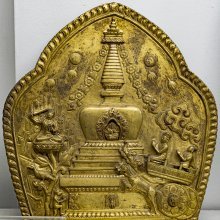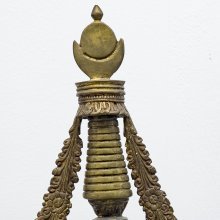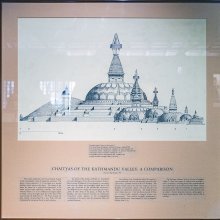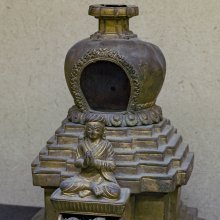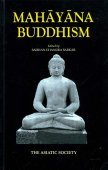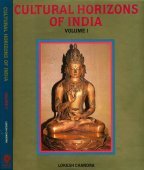Caitya, Chaitya: 24 definitions
Introduction:
Caitya means something in Buddhism, Pali, Hinduism, Sanskrit, Jainism, Prakrit, the history of ancient India, Hindi. If you want to know the exact meaning, history, etymology or English translation of this term then check out the descriptions on this page. Add your comment or reference to a book if you want to contribute to this summary article.
Alternative spellings of this word include Caitya.
Images (photo gallery)
(+69 more images available)
In Hinduism
Purana and Itihasa (epic history)
Source: Wisdom Library: MahābhārataOne of the five large hills protecting the city of Girivraja. Mentioned in the Mahabharata, Second book, Section XXI; The other hills being: Varaha, Vaihara, Vrishava, Rishigiri;
Source: archive.org: Shiva Purana - English TranslationCaitya (चैत्य) refers to a “sanctuary” which makes a preferable site for the performance of a sacrifice, as mentioned in the Śivapurāṇa 1.18.—Accordingly, “[...] the precincts of a temple, a cowshed, a sanctuary (caitya) or one’s own court-yard shall be selected for the performance of sacrifice. It shall be on a raised platform at least two hastas high. It shall be well decorated. Paddy weighing a Bhāra shall be spread on the ground to make a large circle. Diagrams of lotuses shall be made in the middle and in the eight quarters on the border of the circle. [...]”.
Source: Cologne Digital Sanskrit Dictionaries: The Purana Index1a) Caitya (चैत्य).—Funerary mound; found in Ayodhyā; its trees as frequented by Piśācas;1 a householder to avoid Caitya.2
- 1) Bhāgavata-purāṇa IX. 11. 27; Brahmāṇḍa-purāṇa III. 7. 415; Viṣṇu-purāṇa III. 12. 13.
- 2) Viṣṇu-purāṇa III. 11. 122.
1b) A Marut of the first gaṇa.*
- * Brahmāṇḍa-purāṇa III. 5. 92.

The Purana (पुराण, purāṇas) refers to Sanskrit literature preserving ancient India’s vast cultural history, including historical legends, religious ceremonies, various arts and sciences. The eighteen mahapuranas total over 400,000 shlokas (metrical couplets) and date to at least several centuries BCE.
Vastushastra (architecture)
Source: Wisdom Library: Vāstu-śāstraCaitya (चैत्य) refers to a “temple”, and in a broader sense represents “devotional place” or “residence of God”. It is one of commonly used names for a temple, as found in Vāstuśāstra literature such the Mayamata and the Mānasāra.
Source: Digital Library of India: Bharatiya Vastu-sastra volume 1Caitya (चैत्य) is a sacred monument which is piled up like the Vedic Agni (etymologically Caitya is derived from citi).

Vastushastra (वास्तुशास्त्र, vāstuśāstra) refers to the ancient Indian science (shastra) of architecture (vastu), dealing with topics such architecture, sculpture, town-building, fort building and various other constructions. Vastu also deals with the philosophy of the architectural relation with the cosmic universe.
Ayurveda (science of life)
Source: archive.org: Vagbhata’s Ashtanga Hridaya Samhita (first 5 chapters)Caitya (चैत्य) refers to a “tope”, and is mentioned in verse 2.33 of the Aṣṭāṅgahṛdayasaṃhitā (Sūtrasthāna) by Vāgbhaṭa.—Accordingly, “[...] one shall not tread on the shadow of a tope [viz., caitya], respectable (person), flag, and inauspicious (object) or on ashes, chaff, and impure (places), nor (shall one tread) on gravel, clods, and offering and bathing sites”.
Note: Caitya may be a tope as well as a sacred tree (usually the Pipal or Bodhi tree, Ficus religiosa L.) in Buddhist terminology. The Tibetan equivalent mchod-rten denotes only the former, its etymology being “receptacle of oblations”; the latter is called mchod-rten-śiṅ, which corresponds to Sanskrit Caityadruma.
Source: gurumukhi.ru: Ayurveda glossary of termsCaitya (चैत्य):—Religious or sacred tree.

Āyurveda (आयुर्वेद, ayurveda) is a branch of Indian science dealing with medicine, herbalism, taxology, anatomy, surgery, alchemy and related topics. Traditional practice of Āyurveda in ancient India dates back to at least the first millenium BC. Literature is commonly written in Sanskrit using various poetic metres.
In Buddhism
Mahayana (major branch of Buddhism)
Source: academia.edu: A Study and Translation of the GaganagañjaparipṛcchāCaitya (चैत्य) refers to “shrines” (dedicated to the Victorious One—Jina), according to the Gaganagañjaparipṛcchā: the eighth chapter of the Mahāsaṃnipāta (a collection of Mahāyāna Buddhist Sūtras).—Accordingly, “Then the Lord spoke the following verses to the Bodhisattva Puṇyālaṃkāra: ‘[...] (235) Even though the Bodhisattva places a lamp on shrines (caitya) dedicated to the Victorious One, which is filled with perfumed oil like the ocean in ten directions and made of a wick like the Mount Sumeru, if there is someone who, having known that the whole world is covered by darkness, upholds this dharma taught by the Victorious One when the lamp of the dharma is extinguished, then his merit would be better. [...]’”

Mahayana (महायान, mahāyāna) is a major branch of Buddhism focusing on the path of a Bodhisattva (spiritual aspirants/ enlightened beings). Extant literature is vast and primarely composed in the Sanskrit language. There are many sūtras of which some of the earliest are the various Prajñāpāramitā sūtras.
General definition (in Buddhism)
Source: WikiPedia: BuddhismA chaitya is a Buddhist or Jain shrine including a stupa. In modern texts on Indian architecture, the term chaitya griha is often used to denote assembly or prayer hall that houses a stupa. Architecturally they show similarities to Roman design concepts of column and arch.
Source: eBooks@Adelaide: A Record of Buddhistic KingdomsTo the east of the Abhayagiri-vihara there is a hill, with a vihara on it, called the Chaitya, where there may be 2000 monks.
In Jainism
General definition (in Jainism)
Source: HereNow4u: Jain Dharma ka Maulika Itihasa (2)Caitya (चैत्य) refers to “auspicious installations” and is one of the topics treated in the Jñātādharmakathā, one of the Dvādaśāṅgī (twelve Aṅgas) of Jainism.—The Jñātādharmakathā is the sixth text of the Aṅga series. The text narrates religious stories, citing examples. It deals with a multitude of topics like—the cities, gardens, auspicious installations (caityas), forests, kings, parents, samavaśaraṇas (holy conference / congregation hall), dharmācāryas (religious preceptors / leaders), religious parables, mundane and spiritual prosperity, luxury (bhoga), parityāga (sacrifice), pravrajyā (initiation), severe austerities, achieving pious death (e.g. paryāya saṃlekhanās, bhakta pratyākhyāna, pādopagamana, (going to heaven)), birth in high family, enlightenment, last-rites (antaha) of Meghakumāra etc. [...]

Jainism is an Indian religion of Dharma whose doctrine revolves around harmlessness (ahimsa) towards every living being. The two major branches (Digambara and Svetambara) of Jainism stimulate self-control (or, shramana, ‘self-reliance’) and spiritual development through a path of peace for the soul to progess to the ultimate goal.
India history and geography
Source: Cologne Digital Sanskrit Dictionaries: Indian Epigraphical GlossaryCaitya.—(EI 22, 33; BL), a prayer hall; usually, a place of worship in a Buddhist monastery; same as caitya-gṛha. (EI 6, CII 4), same as stūpa. Note: caitya is defined in the “Indian epigraphical glossary” as it can be found on ancient inscriptions commonly written in Sanskrit, Prakrit or Dravidian languages.

The history of India traces the identification of countries, villages, towns and other regions of India, as well as mythology, zoology, royal dynasties, rulers, tribes, local festivities and traditions and regional languages. Ancient India enjoyed religious freedom and encourages the path of Dharma, a concept common to Buddhism, Hinduism, and Jainism.
Languages of India and abroad
Sanskrit dictionary
Source: DDSA: The practical Sanskrit-English dictionaryCaitya (चैत्य).—a. Relating to a pile.
-tyaḥ The individual soul.
-tyam 1 The ant-hill; नागहेतोः सुपर्णेन चैत्यमुन्मथितं यथा (nāgahetoḥ suparṇena caityamunmathitaṃ yathā) Rām.4.19.24.
2) A pile of stones forming a landmark.
3) A monument, tomb-stone.
4) A sacrificial shed; देवस्थानेषु चैत्येषु नागानामालयेषु च (devasthāneṣu caityeṣu nāgānāmālayeṣu ca) Mahābhārata (Bombay) 3.19.67; कच्चिच्चैत्यशतैर्जुष्टः (kacciccaityaśatairjuṣṭaḥ) Rām.2.1.43; प्रासादगोपुरसभाचैत्यदेव- गृहादिषु (prāsādagopurasabhācaityadeva- gṛhādiṣu) Bhāgavata 9.11.27.
5) A place of religious worship, altar, sanctuary.
6) A temple.
7) A reflection.
8) A religious fig-tree or any tree growing by the side of streets; चैत्ययूपाङ्किता भूमिर्यस्येयं सवनाकरा (caityayūpāṅkitā bhūmiryasyeyaṃ savanākarā) Mahābhārata (Bombay) 1.1.229; Meghadūta 23 (rathyāvṛkṣa Malli.)
Source: Cologne Digital Sanskrit Dictionaries: Edgerton Buddhist Hybrid Sanskrit DictionaryCaitya (चैत्य) or Ceti or Cetika or Cetiya.—qq.v. (see § 3.115): ceti bhu (mss. bhū, Lefm. em. m.c., printing cetibhu as one word) trisahasraḥ kiṃ punas tubhya kāyaḥ Lalitavistara 368.18 (verse), the 3000-fold world has become (= abhūt) an [Page233-a+ 71] object of reverence (a shrine)…So Tibetan: stoṅ gsum (= 3,000) mchod rten (= caitya) gyur na (become)…
--- OR ---
Caitya (चैत्य).—nt., like its MIndic substitutes ceti, cetika, cetiya (also caityaka), seems to be used more broadly than in Sanskrit, as any object of veneration: lokasya caityam Śikṣāsamuccaya 56.11 (said of any ornament of a stūpa); 136.2 (of the monkish robes); caitya-bhūtaḥ Vajracchedikā 34.12, of the nature of an object of veneration (said of any place where ‘this sūtra’ shall be proclaimed). See mahācaitya.
Source: Cologne Digital Sanskrit Dictionaries: Shabda-Sagara Sanskrit-English DictionaryCaitya (चैत्य).—m.
(-tyaḥ) A sacred tree, a religious fig tree, &c. growing in a village or near it, and held in veneration by the villagers. n.
(-tyaṃ) 1. A place of sacrifice or religious worship, an altar, a shed kept for sacrifices, &c. 2. A religious building peculiar to the Jainas, a Jaina temple. 3. A Jaina or Baud'dha image, &c. 4. A monument a tomb-stone, a column, &c. erected in memory of some deceased person, or on the site of a funeral pile. 5. A pile of stones forming a land-mark or boundary. E. ci to collect, deriv. irr.; or cit to consider, affix kyap; citya and aṇ aff. cittasya idam aṇ .
Source: Cologne Digital Sanskrit Dictionaries: Benfey Sanskrit-English DictionaryCaitya (चैत्य).—I. probably citi + ya, m. The individual soul, [Bhāgavata-Purāṇa, (ed. Burnouf.)] 3, 26, 61. Ii. citā + ya, m. and n. 1. A tomb, Mahābhārata 12, 914. 2. An altar, [Rāmāyaṇa] 1, 13, 30. 3. A religious building, [Rāmāyaṇa] 5, 17, 20. 4. A sacred tree; a religious fig-tree growing in a village, or near it, and held in veneration by the villagers, [Hiḍimbavadha] 1, 40.
Source: Cologne Digital Sanskrit Dictionaries: Cappeller Sanskrit-English DictionaryCaitya (चैत्य).—1. [masculine] the individual soul.
--- OR ---
Caitya (चैत्य).—2. [adjective] relating to the funeral pile; [masculine] monument, tombstone, temple, also = seq.
Source: Cologne Digital Sanskrit Dictionaries: Monier-Williams Sanskrit-English Dictionary1) Caitya (चैत्य):—[from caitaki] 1. caitya m. ([from] 5. cit or 2. citi) the individual soul, [Bhāgavata-purāṇa iii, 26; 28, 28; 31, 19; Sarvadarśana-saṃgraha ii, 198f.]
2) 2. caitya mfn. relating to a funeral pile or mound (citā), [Āśvalāyana-gṛhya-sūtra iii, 6; Gṛhyāsaṃgraha ii, 4]
3) m. n. a funeral monument or Stūpa (q.v.) or pyramidal column containing the ashes of deceased persons, sacred tree ([especially] a religious fig-tree) growing on a mound, hall or temple or place of worship ([especially] with, [Buddhist literature] and, [Jaina literature] and generally containing a monument), a sanctuary near a village, [Āśvalāyana-gṛhya-sūtra i, 12; Parāśara-smṛti; Yājñavalkya ii, 151 & 228; Mahābhārata] etc.
4) m. a Jain or, [Buddhist literature] image, [cf. Lexicographers, esp. such as amarasiṃha, halāyudha, hemacandra, etc.]
5) = tyaka, [ii, 814].
Source: Cologne Digital Sanskrit Dictionaries: Yates Sanskrit-English Dictionary1) Caitya (चैत्य):—(tyaṃ) 1. n. A place of sacrifice; a monument. m. Ficus religiosa.
2) (tyaḥ) 1. m. Spirit.
Source: DDSA: Paia-sadda-mahannavo; a comprehensive Prakrit Hindi dictionary (S)Caitya (चैत्य) in the Sanskrit language is related to the Prakrit words: Cei, Ceia, Cetta.
[Sanskrit to German]
Sanskrit, also spelled संस्कृतम् (saṃskṛtam), is an ancient language of India commonly seen as the grandmother of the Indo-European language family (even English!). Closely allied with Prakrit and Pali, Sanskrit is more exhaustive in both grammar and terms and has the most extensive collection of literature in the world, greatly surpassing its sister-languages Greek and Latin.
Hindi dictionary
Source: DDSA: A practical Hindi-English dictionaryCaitya (चैत्य) [Also spelled chaity]:—(nm) a monastery, (esp. Buddhist) shrine.
...
Kannada-English dictionary
Source: Alar: Kannada-English corpusCaitya (ಚೈತ್ಯ):—[adjective] relating to the pyre.
--- OR ---
Caitya (ಚೈತ್ಯ):—
1) [noun] a monument erected at a place where the ashes of a corpse burn, is buried.
2) [noun] a sacrificial shed.
3) [noun] a place of worship for Buddhists or Jainas; a building containing some relic¸À of Buddha or Jaina.
4) [noun] the individual soul.
5) [noun] the fig tree Ficus religiosa of Moraceae family; peepul; bo-tree.
Kannada is a Dravidian language (as opposed to the Indo-European language family) mainly spoken in the southwestern region of India.
See also (Relevant definitions)
Starts with (+6): Caitya-patta, Caitya-shaila, Caityabhuta, Caityadru, Caityadruma, Caityageha, Caityagni, Caityagriha, Caityaka, Caityaka-shaila, Caityalaya, Caityamandira, Caityamukha, Caityapala, Caityaparipati, Caityapurusha, Caityasailah, Caityasthana, Caityataru, Caityavandana.
Ends with: Buddha-caitya, Dharmadevacaitya, Gramacaitya, Jinacaitya, Keshacaitya, Lalitacaitya, Mahacaitya, Munirajacaitya, Nirvana-caitya, Siddhacaitya.
Full-text (+377): Caityavriksha, Caityadruma, Caityamukha, Caityapala, Kashayagrahana, Caityadru, Cetta, Lalitacaitya, Chandakanivartana, Cudapratigrahana, Caityataru, Ceia, Keshacaitya, Caitya-shaila, Vandaka, Caityayajna, Caitika, Capala, Saptamra, Caityagriha.
Relevant text
Search found 82 books and stories containing Caitya, Chaitya; (plurals include: Caityas, Chaityas). You can also click to the full overview containing English textual excerpts. Below are direct links for the most relevant articles:
Vastu-shastra (1): Canons of Architecture (by D. N. Shukla)
(vi) Rise of Art < [Chapter 4 - An outline History of Hindu Architecture]
(v,2) Vāstu in Epic literature < [Chapter 4 - An outline History of Hindu Architecture]
(v,3) Vāstu in Buddhist Literature (Jātakas and Pali Canons) < [Chapter 4 - An outline History of Hindu Architecture]
Amaravati Art in the Context of Andhra Archaeology (by Sreyashi Ray chowdhuri)
Lower Kṛṣṇā Valley (11): Gunṭupalli < [Chapter 2 - Amarāvatī and other Archaeological Sites of Ancient Andhra Pradesh]
The rule of the Sātavāhanas < [Chapter 4 - Survival of Amarāvatī in the Context of Andhra Art]
Lower Kṛṣṇā Valley (30): Chejarla < [Chapter 2 - Amarāvatī and other Archaeological Sites of Ancient Andhra Pradesh]
Amarakoshodghatana of Kshirasvamin (study) (by A. Yamuna Devi)
Town Planning (4): Other Constructions < [Chapter 3 - Social Aspects]
Town Planning (1): City < [Chapter 3 - Social Aspects]
Nagarjunikonda < [April 1955]
Buddhist Vestiges of Andhradesa < [July – September, 1994]
Glimpses of Ancient India < [January – March, 2001]
Sripura (Archaeological Survey) (by Bikash Chandra Pradhan)
Vaisnava Temples (1): Laksmana Temple < [Chapter 2 - The Architectural Panorama]
Jaina Vihara < [Chapter 2 - The Architectural Panorama]
Vastu-shastra (5): Temple Architecture (by D. N. Shukla)
Stūpas (Shrines for Devotion) < [Chapter 12 - History of Hindu Temples (Prāsādas and Vimānas)]
Chapter 1 - Denotation of the term ‘prāsāda’—the hindu temple
Guhādharas (Buddhist rock-cut architecture) < [Chapter 12 - History of Hindu Temples (Prāsādas and Vimānas)]
Related products

